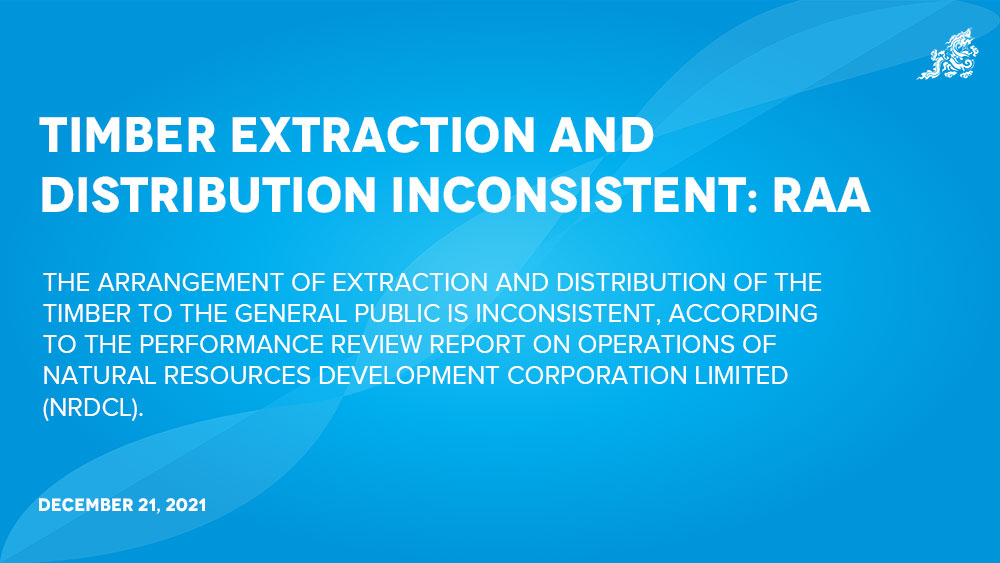Dechen Dolkar
The arrangement of extraction and distribution of the timber to the general public is inconsistent, according to the performance review report on operations of Natural Resources Development Corporation Limited (NRDCL).
Timber extraction and distribution modality (TEDM) 2017 was initiated as an interim measure to resolve the disputes between the NRDCL and the Association of Wood-based Industries (AWBI) on their allotment shares. The NRDCL and AWBI take their 50 percent share to be sold to customers.
The report states that the current arrangement of distribution – 50 percent share each, as per TEDM – may not ensure equal accessibility of natural resources, as there are no procedures in place for distribution amongst members of the AWBI, and further, to the general public.
Moreover, it states that despite prices being fixed by the Natural Resources Pricing Committee (NRPC), there are possibilities for undue profiteering through exorbitant pricing that could be charged to the consumers due to weak enforcement and monitoring.
Deputy Auditor General Dorji Wangchuk said that saw millers were not able to get the desired quantity of the timber, which resulted in their machines lying idle for two to three months out of the year.
He said that the AWBI was not the representative of all the saw millers in the country and was not a legally registered association, and that it may not have a desirable legal stand to bargain for its share of allotment through TEDM.
AWBI has 111 registered members out of 130 saw millers in the country.
The report also pointed out that there were inconsistencies in the mandates as inferred from the charter, executive orders, and objectives of an article of incorporation that may potentially impede the performance and delivery of legitimate mandates.
The RAA also noted inconsistencies in applying Section 366 (6) of forest and nature conservation rules and regulations (FNCRR) 2017 in regard to surface collections and dredging activities. These were based on RAA’s review report on surface collection and dredging of riverbed materials conducted in 2018.
Dorji Wangchuk said that the investment decision based on the government’s executive order 2010 to open crushing units had an adverse impact on the profitability of the company through 2011-2019.
He said that the operation of crushing units had neither facilitated the company in achieving its commercial objectives of making profits, nor complemented its efforts in fulfilling social mandates.
He also said that the NRDCL was not seen as capable of playing its role in the overall sustainable resource management in the country.
“The fragmented approach towards extraction of timber by different parties besides the NRDCL may not ensure a consolidated approach in the overall management of forests in the country,” he said.
The RAA’s review of operations of the NRPC in determining prices of natural resources with specific reference to price determination showed inadequacies in terms of process and methods of fixing prices, as well as the functioning of the committee.
He said that the Department of Forest and Park Services (DoFPS), which is mandated to monitor the pricing, is not doing so.
The report states that investment in the unprofitable business of stone-crushing units resulted in an accumulated loss of Nu 244.011M.
Dorji Wangchuk said that four crushing units were closed and only two were found to be operational.
The report also states that there were gaps in ensuring compliance to the Service Rules Guidelines for DHI-owned companies and its own service rules in regulating its human resource development and management activities.
Recommendations
The RAA has provided 11 recommendations aimed at improving the operational efficiency of the NRDCL.
The RAA has recommended that DHI, in consultation with the Ministry of Agriculture and Forests (MoAF) should pursue the government to review and reinforce the mandates of the NRDCL.
The Authority has recommended restructuring the company to design its operations to promote its social objectives. The company currently operates a timber, sand, and stone business, mainly focusing on extraction with limited involvement in value addition.
It is also recommended that the NRDCL reinforce clear coordination mechanisms in consultation with the MoAF and Ministry of Economic Affairs.
It states that the inadequacies noted in coordination with various agencies and stakeholders were found to cause impediments in attaining efficiency in its operations and in the delivery of its services.
The MoAF, the Authority said, should develop comprehensive guidelines for the functions of the NRPC to reduce inadequacies in managing the affairs of the committee in terms of composition of committees, organizing meetings, recording decisions, and determining the prices.
Dorji Wangchuk said that the company caters to about 95 percent of the sand market in the country and it is the only area in which the company has shown consistent revenue.
“With a market share of only 30 percent for timber in the country, it has minimal influence on setting the trend of timber prices, as the demand for 70 percent of the market is met from other sources,” he said.


